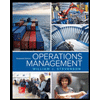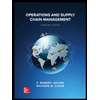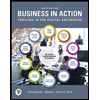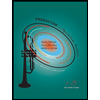Temperature is used to measure the output of a production process. When the process is in control, the mean of the process is = 127.5 and the standard deviation is a 0.4. (a) Compute the upper and lower control limits if samples of size 6 are to be used. (Round your answers to two decimal places.) UCL = LCL =
Temperature is used to measure the output of a production process. When the process is in control, the mean of the process is = 127.5 and the standard deviation is a 0.4. (a) Compute the upper and lower control limits if samples of size 6 are to be used. (Round your answers to two decimal places.) UCL = LCL =
Practical Management Science
6th Edition
ISBN:9781337406659
Author:WINSTON, Wayne L.
Publisher:WINSTON, Wayne L.
Chapter2: Introduction To Spreadsheet Modeling
Section: Chapter Questions
Problem 20P: Julie James is opening a lemonade stand. She believes the fixed cost per week of running the stand...
Related questions
Question
![## Control Limits in Production Process Monitoring
**Topic: Computing Control Limits for Monitoring Production Processes Using Temperature**
Temperature is often employed to measure the output of a production process to ensure quality control. When evaluating the process, if it is deemed to be in control, it typically follows defined statistical parameters.
### Given Parameters:
- **Mean of the process (μ)**: 127.5
- **Standard deviation (σ)**: 0.4
### Problem:
Compute the upper and lower control limits if samples of size 6 are to be used. Ensure to round your answers to two decimal places.
### Solution Approach:
1. **Control Limits** are determined based on the desired confidence level, typically using the formula for control limits in a standard normal distribution.
2. **Formulas for Control Limits**:
- **Upper Control Limit (UCL)**:
\[ UCL = \mu + Z \times \left(\frac{\sigma}{\sqrt{n}}\right) \]
- **Lower Control Limit (LCL)**:
\[ LCL = \mu - Z \times \left(\frac{\sigma}{\sqrt{n}}\right) \]
Where:
- \( \mu \) = Mean of the process
- \( \sigma \) = Standard deviation
- \( Z \) = Z-value (typically 3 for 99.73% confidence)
- \( n \) = Sample size
### Solution:
- **Sample Size (n)**: 6
- **Z-value for 99.73% Confidence** (commonly used in control charts): 3
- **Calculation**:
\[ UCL = 127.5 + 3 \times \left(\frac{0.4}{\sqrt{6}}\right) \]
\[ LCL = 127.5 - 3 \times \left(\frac{0.4}{\sqrt{6}}\right) \]
### Results:
- **UCL =** [Input box for users to compute]
- **LCL =** [Input box for users to compute]
This computation allows process engineers to monitor and control the production process efficiently, ensuring that deviations remain within acceptable limits for quality assurance.](/v2/_next/image?url=https%3A%2F%2Fcontent.bartleby.com%2Fqna-images%2Fquestion%2F4959d4f7-c515-4b84-8a14-00389cef5562%2F0e11cfb0-96bd-4812-a46c-84f055b3490f%2Ffrbd9pm_processed.jpeg&w=3840&q=75)
Transcribed Image Text:## Control Limits in Production Process Monitoring
**Topic: Computing Control Limits for Monitoring Production Processes Using Temperature**
Temperature is often employed to measure the output of a production process to ensure quality control. When evaluating the process, if it is deemed to be in control, it typically follows defined statistical parameters.
### Given Parameters:
- **Mean of the process (μ)**: 127.5
- **Standard deviation (σ)**: 0.4
### Problem:
Compute the upper and lower control limits if samples of size 6 are to be used. Ensure to round your answers to two decimal places.
### Solution Approach:
1. **Control Limits** are determined based on the desired confidence level, typically using the formula for control limits in a standard normal distribution.
2. **Formulas for Control Limits**:
- **Upper Control Limit (UCL)**:
\[ UCL = \mu + Z \times \left(\frac{\sigma}{\sqrt{n}}\right) \]
- **Lower Control Limit (LCL)**:
\[ LCL = \mu - Z \times \left(\frac{\sigma}{\sqrt{n}}\right) \]
Where:
- \( \mu \) = Mean of the process
- \( \sigma \) = Standard deviation
- \( Z \) = Z-value (typically 3 for 99.73% confidence)
- \( n \) = Sample size
### Solution:
- **Sample Size (n)**: 6
- **Z-value for 99.73% Confidence** (commonly used in control charts): 3
- **Calculation**:
\[ UCL = 127.5 + 3 \times \left(\frac{0.4}{\sqrt{6}}\right) \]
\[ LCL = 127.5 - 3 \times \left(\frac{0.4}{\sqrt{6}}\right) \]
### Results:
- **UCL =** [Input box for users to compute]
- **LCL =** [Input box for users to compute]
This computation allows process engineers to monitor and control the production process efficiently, ensuring that deviations remain within acceptable limits for quality assurance.
Expert Solution
This question has been solved!
Explore an expertly crafted, step-by-step solution for a thorough understanding of key concepts.
Step by step
Solved in 4 steps

Recommended textbooks for you

Practical Management Science
Operations Management
ISBN:
9781337406659
Author:
WINSTON, Wayne L.
Publisher:
Cengage,

Operations Management
Operations Management
ISBN:
9781259667473
Author:
William J Stevenson
Publisher:
McGraw-Hill Education

Operations and Supply Chain Management (Mcgraw-hi…
Operations Management
ISBN:
9781259666100
Author:
F. Robert Jacobs, Richard B Chase
Publisher:
McGraw-Hill Education

Practical Management Science
Operations Management
ISBN:
9781337406659
Author:
WINSTON, Wayne L.
Publisher:
Cengage,

Operations Management
Operations Management
ISBN:
9781259667473
Author:
William J Stevenson
Publisher:
McGraw-Hill Education

Operations and Supply Chain Management (Mcgraw-hi…
Operations Management
ISBN:
9781259666100
Author:
F. Robert Jacobs, Richard B Chase
Publisher:
McGraw-Hill Education


Purchasing and Supply Chain Management
Operations Management
ISBN:
9781285869681
Author:
Robert M. Monczka, Robert B. Handfield, Larry C. Giunipero, James L. Patterson
Publisher:
Cengage Learning

Production and Operations Analysis, Seventh Editi…
Operations Management
ISBN:
9781478623069
Author:
Steven Nahmias, Tava Lennon Olsen
Publisher:
Waveland Press, Inc.